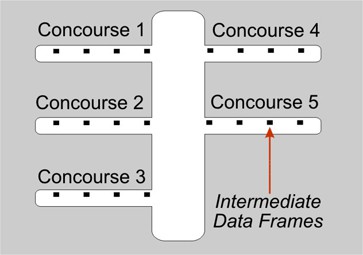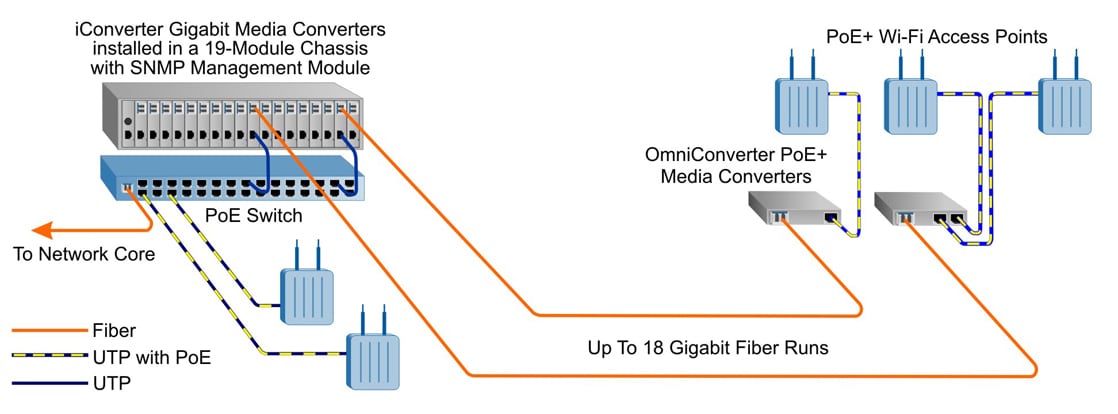Main Menu
Useful Links
Contact us
Follow us
© 2025 Omnitron Systems Technology, Inc. All Rights Reserved. | Privacy Policy

Airports across the country are in the process of upgrading their network infrastructure to support the growing demands for both Wi-Fi access and video surveillance.
To overcome the distance limitation of copper cabling, fiber optic cabling is routed to terminals, concourses, parking structures and runways where Wi-Fi access points and cameras are located. Since most of the devices are not conveniently located near power sources, Wi-Fi access points and cameras with Power over Ethernet (PoE) are installed.
Design and install a cost-effective solution that enables the powering of hundreds of PoE devices across a fiber optic wide area network and supports extended temperatures for outdoor installations, with the ability to perform remote PoE power reboots to the connected devices.

To meet the demands of travelers, airports have started offering free Wi-Fi with increased speeds. This can require the entire wireless infrastructure to be redesigned and upgraded.
A large International Airport in the Southeast is now on the growing list of major international airports to offer customers free Wi-Fi. The entire airport has become a huge wireless hot spot, allowing nearly 100 million passengers per year access to Internet service from virtually any point.
The City Department of Aviation was responsible for the design and deployment of the Wi-Fi network at the airport. They worked with a large system integrator on the project to install over 300 Wi-Fi access points throughout the 6.8 million square foot terminal complex.
Fiber was distributed from the central internet Point of Presence at the network core to Intermediate Distribution Frames (IDF), or electrical network closets, throughout the airport. A PoE switch was installed in each IDF, and multiple Wi-Fi access points were connected to each switch. Each concourse has four IDFs, where gigabit network links were distributed from PoE switches in a hub and spoke topology. Depending on the location in the concourse, about half of the switches required a chassis of media converters to enable fiber connectivity to the access points.
“The design of the network was relatively straight forward,” said the Project Manager for the City Department of Aviation. “We had a scale map of each Concourse, so as we placed the access points, we knew exactly where we needed fiber runs to reach beyond the 300 foot distance limit of copper cable.”

They selected Omnitron Systems’ iConverter media converters to provide high-density fiber distribution from the switches. iConverter gigabit media converters were installed in a 19-module chassis along with an SNMP management module. Up to 18 gigabit fiber runs were distributed from each switch to the access points.
“We deployed Omnitron’s iConverter media converters in the original Wi-Fi network, and we found them to be very reliable,” said the Project Manager. “The media converters were installed about eight years ago. They didn’t need any maintenance or reboots, and they never went down.”
The access points required 30 watts of Power over Ethernet (PoE+), and due to the high volume of access points deployed throughout the airport, they needed a cost-effective and compact solution to convert the fiber to copper, and provide PoE+ power.
At the end of each fiber run, the City Department of Aviation installed OmniConverter PoE media converters to convert the fiber to copper, and provide PoE+ power to one or two wireless access points. The OmniConverters provided the gigabit copper to fiber conversion, and eliminated the need for a mid-span device, or for the Airport to install expensive AC power outlets near each camera. They installed the OmniConverter media converters close to the access points to simplify troubleshooting, although the access points could be located up to 300 feet away from the OmniConverter media converters.
One of the many reasons the OmniConverter was selected for the project is the ability to remotely reboot the wireless access point without physically accessing the device. The configurable PoE Power Reset function on the OmniConverter PoE media converters enables the access point to be remotely reset by disconnecting the fiber optic cable at the IDF. When a problem with an access point is identified, the fiber port at the IDF can be shut down or disconnected. The OmniConverter disables power for 2 seconds when a loss of receive fiber link is detected, and the access point is rebooted. This eliminated the need to send a tech with a ladder up to the ceiling to power cycle the access point.
The new Wi-Fi network was installed in less than 30 days, and the network now provides access to 15,000 simultaneous users, with download speeds up to 5Mbps. “A state-of-the-art wireless network is required to support this high number of users, and this requires a state-of-the-art fiber backhaul network,” the Project Manager noted. “Our fiber backhaul and PoE network is holding up perfectly.”
Historically, video surveillance is used by the TSA, airport security and U.S. Customs and Border Protection to ensure the safety and security of the public at airports. Video surveillance now covers the entire airport, from parking lots to the perimeter, and from the terminals to baggage claim.
A similar concept used to deploy the Wi-Fi network was employed to connect the PoE IP surveillance cameras. Fiber cabling from the security office at the network core connected to Intermediate Distribution Frames where network PoE switches were deployed. iConverter gigabit media converters were installed at each IDF to provide high-density fiber distribution from the switches to the cameras.
The video surveillance was a little more challenging to deploy than the wireless network because there were fewer IDFs outside the concourse, and a more extensive area needed to be covered. OmniConverter PoE media converters with two fiber ports were deployed, allowing the airport to daisy-chain the converters over longer distances in the parking lots. Another challenge was that many of the cameras were located outdoors and required hardened network equipment.

OmniConverter copper-to-fiber gigabit media converters were placed across the airport facility in convenient locations near power outlets. Several daisy-chain fiber links were run to light poles in the parking lots that provided excellent camera locations and power for the temperature hardened OmniConverter PoE media converters installed in NEMA enclosures. Each OmniConverter powered one or two PoE+ cameras, and in some locations, two HPoE 60 watt cameras.
After the installation of the video surveillance network, the entire airport was being monitored from a central location. The daisy-chain topology allowed long distances to be covered and preserved fiber optic cabling. Since the network covered such a large area, the PoE Power Reset feature on the OmniConverters eliminated the need for the airport to send out personnel to physically reset the equipment.
Omnitron’s OmniConverter PoE media converters provided a compact and cost-effective commercial and temperature hardened solution that enabled the airport to extend distances to PoE devices with fiber. The variety of port configurations available in the OmniConverter product family provided the flexibility for the airport to connect the devices in point-to-point or daisy-chain topologies. Regardless of the powering requirements of the wireless access points or cameras, the OmniConverter has the ability to power PoE, PoE+ and HPoE devices, eliminating the need to purchase or stock multiple PoE devices.